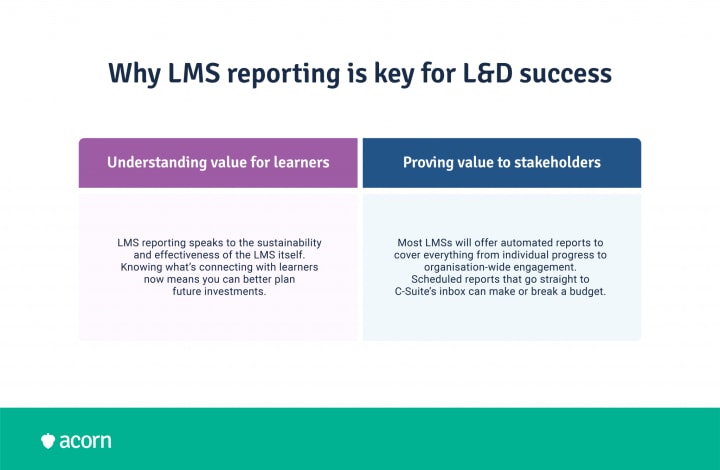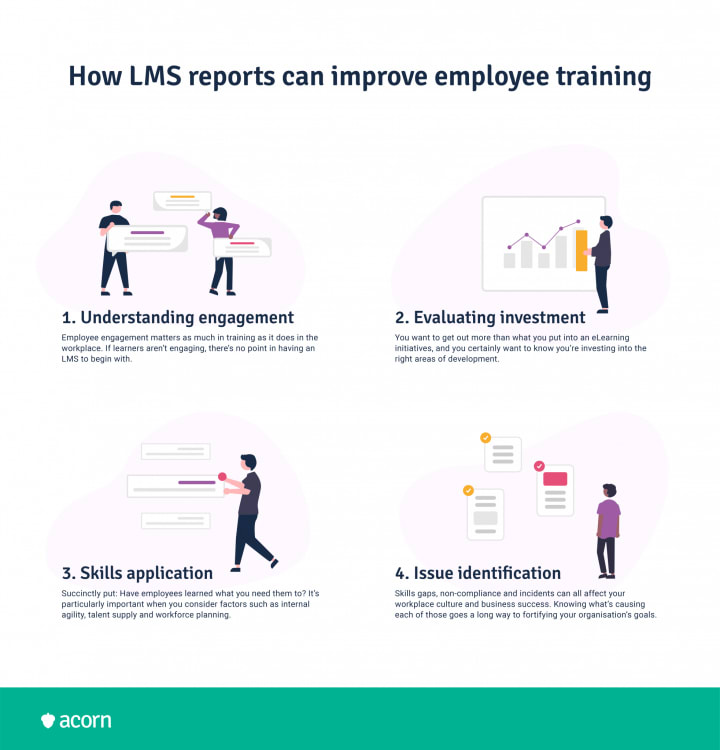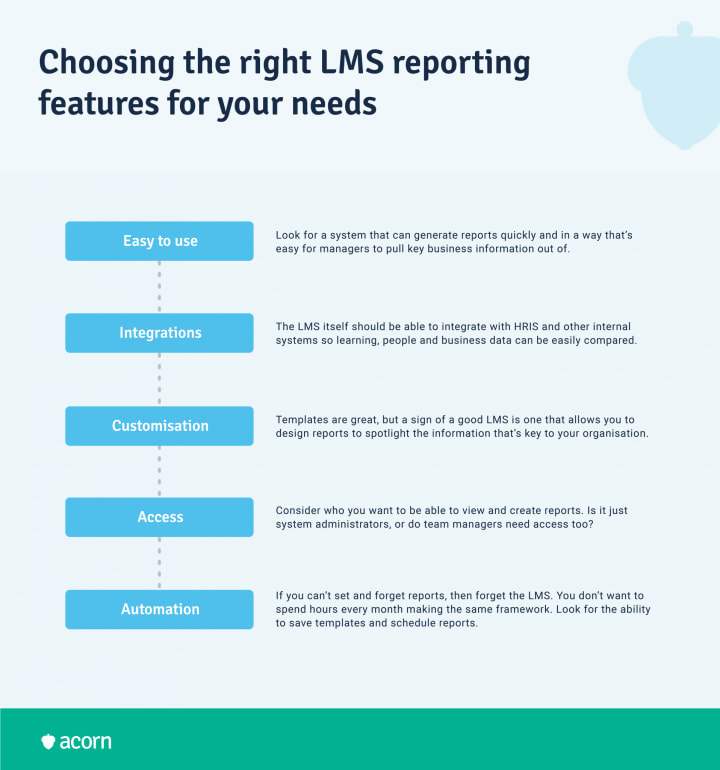
This article first appeared on Acorn Labs in September 2021.
Your learning management system is not just a tool for delivering learning. It’s also your key to understanding the effectiveness of your learning initiatives through reporting and analytics.
A commonly underrated element of your learning management system (LMS) is reporting, which is as important as learning itself. Without robust LMS reporting features, you’ll lack the valuable data needed to address knowledge gaps, improve employee performance, provide information for key stakeholders and facilitate a streamlined training process.
Let’s walk through what LMS reporting is, why you should care about tracking and reporting on learning, and the key metrics and reports you need to boost the efficacy of L&D in your organisation.
What is LMS reporting?
LMS reporting refers to how a learning management system collects and analyses data. The system will have metrics that give you a complete picture of learner-related data such as user progress, performance and rates of completion. This helps you understand how effective your eLearning programs are.
Why is LMS reporting so important?
The main reason LMS reporting is crucial to your business is that it allows you to view big data in a succinct and digestible way. Most organisations have more data than ever at their disposal. That’s a lot of information to sift through and prioritise, particularly when you’re accessing it in real-time. Yet that same speed gives your organisation agility over your competitors.
Collecting data for corporate training within an entire organisation can be tedious. A centralised point for storage, collection and analysis is important for comparing systems during the buying process and even measuring the validity of integrations, plus it just makes life easier for your LMS administrators.
But when it comes to employee training, there are two key reasons that you want robust LMS reporting capabilities:
- Getting the most value out of your L&D investment; and
- Proving L&D value to stakeholders.
Optimising resources
LMS reporting (and LMS reporting data) is made to measure the LMS itself. In this way, it speaks to the feasibility of an LMS’s ability to serve your organisation’s needs. Considering content can cost extra on top of some licenses—and it’s what your learners are accessing the LMS for—getting the most out of that content is important. Being able to see enrolments and completion rates and times gives you clear ideas of what’s working and what’s not.
Beyond saving money, it also enables you to better plan future resources. If a certain program isn’t popular or has low completion rates, you can reconfigure or choose to expire a course completely. If there’s an overflow of enrolments for a virtual training session, you can plan to run more courses in future. It means you’re providing training your employees actually want or find useful, plus minimising risk to your business investments.
Reporting to stakeholders
There’ll always be higher ups who will want to know the ROI of training. But providing regular updates, or indeed, in-depth updates, can be time-intensive—with no let up from the powers that be. You need to be able to demonstrate value through progression and engagement, which is where LMS reporting comes in.
The sheer variety of available LMS reports means all angles can be covered, from individual progress to group goals. Being able to schedule reports takes the hassle of manual data collection off HR’s shoulders, and it also means that any initiatives you want to take to them come budget time can be backed up. Got proof learners engage more with partnered content that might cost more? You can take that to stakeholders. And if any without access to the LMS need learning insights, reports can be sent straight to their inbox. Essentially, LMS reports translate corporate training into real world benefits.

How to boost learning effectiveness with LMS reports
Still unsure of why and how you can leverage reporting metrics to make your employee training efforts more effective and efficient? There are a few opportunities LMS reporting data offers to boost learning effectiveness.

Understanding the impact of eLearning on employee performance is crucial to achieving your learning goals. What have employees actually learned? How well have they retained knowledge? Are completion rates an accurate sign of improved performance? When the goal of employee training is to upskill, reskill or create new capabilities, you want to know those changes are sticking.
Let’s go through some of the specific LMS reports you’ll want to have in your arsenal.
- Learner progress
- Course completions
- Course progress
- Capabilities
- Compliance
- Attendance
- Assessment results
- Feedback & satisfaction
- Instructor feedback.
Learner progress
These are the most all-encompassing LMS reports you’ll get. You can go bird’s eye and report on all users, or narrow down on course completions for an individual. From there, it’s easy to filter by department, team, job role or learner cohort to get an idea of participation.
Why it’s really important to track learner progress
Learner or user progress reports give you the full picture of engagement and interaction. If a user account was created weeks ago but they’ve not completed one course, it might be that they’re struggling to engage. If logins are low across the board, something’s not working for them. And if learners aren’t engaged, your whole investment is a waste.
Consider that disengagement globally costs up to $500 billion every year once you factor in turnover rates, absenteeism, low productivity and lack of innovation, and you can see why progress is critical data.
Course completions
Where a user-focused report can show course completions at an individual level, course completion metrics shows you that data for selected content. Wherever there’s consistently failed or incomplete courses, you’ll want some idea of what’s tripping learners up or causing them to check out.
Why it’s really important to track course completions
If you truly want to optimise your content and provide the best learning environment possible, this is your starting point.
Within this report, you can track the time users enrolled in a course, the time started and time finished—which gives you an idea of both content difficulty and effectiveness. Time logs are a great building block for prerequisite courses; you may be able to better tie complexity levels (beginner, intermediate, advanced) and skillsets to coursework.
Course progress
Wondering about specific users in specific courses, like, say, a compliance or leadership program? Course progress metrics will help you get an idea of individual comprehension.
Why it’s really important to track individual course progress
Consider the scenario in which you’ve spotlighted someone for leadership, but they need to undertake some targeted training (e.g. project management or emotional intelligence) before they can assume new responsibilities.
If you’re on a strict timeline with workforce planning, you can’t have employees floundering with complex content or lacking motivation. A course progress report is a super useful metric for understanding how learners interact with certain courses. On the other hand, this type of course report can help HR make informed decisions on talent with an idea of high-potential and self-motivated employees (hint: they’ll be highly active learners in the LMS).
Capabilities
This might be one you haven’t considered, nor one you’ve come across with providers you’ve worked with before. But it’s a crucial way to use LMS reporting tools to their full advantage.
Business goals are realised by the capabilities of your employees. Capability frameworks are made up of tens, if not hundreds, of skills. By understanding what capabilities are being built in the business (versus random upskilling), your learning initiatives are focused on intentional capability building linked to the business goals.
Why it’s really important to track capabilities
Internal agility has been a buzz term in HR for a while now—for good reason. Your sustainability as an organisation and competitive advantage hinges on your talent supply, which is why you want to be able to predict the capabilities you need in future and fill the gaps between those you have now.
An internal talent marketplace keeps you free from environmental risks, such as a less-than-desirable external market (e.g. a job seeker’s market), rate of technology change and ever-changing skill domains, while ensuring you always have the people and skills on hand you need to respond to changing business dynamics.
Compliance
This is the line between fines and accidents and a well-oiled machine. Compliance training is integral to most, if not all, businesses. Compliance reports can help you keep track of how up to date employees’ compliance knowledge and certifications are, considering expiry dates can be viewed en masse.
Why it’s really important to track compliance training
Automating compliance training is a handy feature of the LMS, because it helps to reduce business risk. If you’re an organisation with thousands of employees complying with industry regulations, you can’t afford (in terms of reputation, and money and time spent) to have non-compliant employees.
Outdated company knowledge or just plain ignorance can cause accidents and leave the company open to fines. Aside from automating governance, frequent compliance reports on the status of both individual and cohort certification decreases the burden of manual management from your L&D leads.
Attendance
Live learnings, virtual sessions and instructor-led training can be a costly addition to your eLearning toolkit, especially if you’re outsourcing facilitators. Enter: The attendance report. In a single report, you can filter by course or learner to understand what is commanding learner engagement and therefore worth the investment.
Why it’s really important to track attendance
An attendance report will help you understand seasonality through a breakdown of:
- Individual attendance. Here, LMS reporting can help identify unapproved absences and gauge levels of motivation between different learners.
- Popular time slots. Employees have conflicting but often shared priorities (school drop off, meetings, social events), which means some time slots will always be more popular than others. If you know which ones regularly overflow with enrolments, you may be able to create more sessions and ensure there are no delays to each individual learner’s progress.
- Session waitlists. Similarly, session waitlists can indicate both popular time slots and interesting, engaging or relevant subject matter.
Assessment results
Ending a course of lectures and readings with a quiz or assignment is fairly standard way to assess efficacy. This report will allow you to see how each question in an exam, for example, is answered, which gives you a clear idea of comprehension.
Why it’s really important to track results
Well, assessment reports are really the main way you can understand if your employees are learning what they need to. They may misinterpret information or fail to translate theory to practice without a test of skills application. This report could also uncover a gap in the learning materials you’re providing.
For example: A project management course may not cover emotional labour, though the end-of-course quiz asks a question about an irrational teammate impeding progress that users routinely get wrong. There’s your chance to develop new and more comprehensive materials for future assessments.
Feedback & satisfaction
While you can get a good idea of engagement from other reports, you can go direct to the source with custom reports that cover satisfaction. Feedback or surveys attached to courses, particularly those that ask learners to rate content or provide detailed opinions, can be arranged in an LMS report.
Why it’s really important to track satisfaction
It’s all well and good if system administrators think a specific course is engaging. But you want your end users to be not only engaged, but invested in learning.
Surveys also give you a good indication of future engagement and therefore, enable you to better forecast learning resources. In the process, you’re also getting employees to self-reflect on the complexity of their learning pathways, which can help individuals better understand their own capabilities.
Instructor feedback
Different to a content-based reflection, seeking feedback from learners about their instructors helps you understand how valuable employees find ILT.
Why it’s important to track instructor feedback
In ILT environments, learners will seek out instructors for feedback or knowledge to fill gaps, so you want to know that a) they’re actually subject matter experts and b) able to lead and manage learners—especially if you’re paying for external trainers. Approval ratings link directly to satisfaction and engagement; so, if learners aren’t connecting with an instructor, they’re very likely to check out of critical courses, which can affect learning outcomes.

In conclusion: You need robust LMS reporting features to improve online training
Both the journey and destination matter in employee training. That’s why LMS reporting tools (that keep track of said journey every step of the way) make for effective learning management systems.
LMS reports help you create a high-level view of the value of online training within your organisation. Frequent, automated and visual data analysis can be used as part of an ROI assessment for C-Suite, and also to optimise spend on learning materials and content.
Depending on the supplier, there are an almost endless list of LMS reports out there to track training. Those that may provide the most value to your organisation include:
- Learner progress
- Course completions
- Course progress
- Capabilities
- Compliance
- Attendance
- Assessment results
- Feedback & satisfaction
- Instructor feedback.
Each gives you a more nuanced understanding of rates of engagement and levels of skills application, which in turn affect your workforce planning efforts, L&D investments and internal talent supply. Don’t underestimate the importance of LMS reporting on that last note: It’s not just about understanding the efficacy of learning for the sake of it. Being able to identify and quantify gaps in skills and knowledge is the key to ensuring your organisation can achieve its business goals.
About the Creator
Acorn
Impact, not overload™
Acorn PLMS (performance learning management system) is a dynamic AI-powered platform for learning experiences synchronized to business performance at every step. Corporate learning is broken. Acorn is the antidote.






Comments
There are no comments for this story
Be the first to respond and start the conversation.